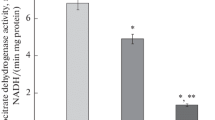Summary
A method to determine14CO2 formed from albumin bond 1-14C fatty acids in human liver biopsies is described. The method was developed mostly using rat liver slices.
Independent upon chain length and number of double bonds fatty acids were oxidized proportional to their concentration in the medium. Short chain and long chain fatty acids did not influence each other. Glucose only depressed the oxidation of short chain fatty acids. Ethanol, on the other hand, decreased the oxidation of long chain and short chain fatty acids.
In human liver biopsies the determination of the molar oxidation rates showed the dominating influence of the chain length. Similar results were obtained with rat liver slices. A maximal rate was found for the C6 fatty acid. The long chain fatty acids showed the lowest oxidation rates. With the exception of the stearic acid they disclosed only minor differences. Stearic acid, which was oxidized much more easily, showed ATP formation rates comparable to those of short chain fatty acids.
In view of the small size of the patient groups data were not correlated to diseases and diets. Both factors, however, were of minor importance in comparison to the influence of the type of the fatty acid.
Zusammenfassung
Es wird eine Methode beschrieben, die es gestattet, das aus albumingebundenen 1-14C-Fettsäuren in menschlichen Leberpunktaten gebildete14CO2 zu bestimmen.
Ein Teil der methodischen Fragen wurde an Rattenleberschnitten überprüft. Fettsäuren wurden unabhängig von Kettenlänge und Zahl der Doppelbindungen konzentrationsabhängig oxidiert. Kurz- und langkettige Fettsäuren beeinflußten sich nicht gegenseitig. Glucose drosselte nur die Oxidation von kurzkettigen Fettsäuren, Äthanol wirkte sich dagegen in gleicher Weise drosselnd auf lang- und kurzkettige Fettsäuren aus.
In menschlichen Leberpunktaten zeigte sich bei der Bestimmung der molaren Oxidationsraten der dominierende Einfluß der Kettenlänge. Das Maximum lag bei der C6-Fettsäure. Am geringsten wurden die langkettigen Fettsäuren oxidiert. Sie wiesen mit Ausnahme der Stearinsäure ein gleichmäßiges Verhalten auf. Die leichter oxidierbare Stearinsäure zeigte eine mit den kurzkettigen Fettsäuren vergleichbare ATP-Bildungsrate.
In Anbetracht der kleinen Kollektive wurde auf eine krankheits- und kostbezogene Auswertung verzichtet. Beide Faktoren spielten aber bei identischen Mediumsverhältnissen im Vergleich zur Art der Fettsäuren nur eine untergeordnete Rolle.
Similar content being viewed by others
Literatur
Bergen, S. S., Jr., Hashim, S. A., Van Itallie, T. B.: Diabetes15, 723 (1966)
Berg, G., Troll, U., Strunk, U.: Klin. Wschr.46, 997 (1968)
Duncombe, W. G.: Biochem. J.88, 7 (1963); Clin. chim. Acta9, 122 (1964)
Fritz, I. B., Kaplan, L.: Amer. J. Physiol.197, 297 (1959)
Fritz, I. B.: Physiol. Rev.41, 52 (1961)
Frotz, H., Oette, K.: Therapiewoche20, 2124 (1970)
Hashim, S. A.: Symp. Erlangen 1968: Fettstoffwechsel 4. Lochham bei München: Pallas 1969
Karlson, P.: Kurzes Lehrbuch der Biochemie. Stuttgart: Thieme 1970
Lieber, C. S.: In: Alkohol und Leber, Symp. Freiburg 1970, S. 207. Stuttgart: Schattauer 1971
Lieber, C. S., Schmid, R.: J. clin. Invest.40, 394 (1961)
Lieber, C. S., Lefevre, A., Spritz, N., Feinman, L., DeCarli, L. M.: J. clin. Invest.46, 1451 (1967)
Lossow, W. J., Chaikoff, J. L.: Arch. Biochem. Biophys.57, 23 (1955)
Ludwig, L.: Fett und Ernährung. Margarine-Institut für Gesunde Ernährung 1968
Oette, K., Phlippen, R., Lanckohr, H.: Res. exp. Med.162, 83 (1974)
Oette, K.: Res. exp. Med.162, 185 (1974)
Oette, K.: In: Alkohol und Leber, Symp. Freiburg 1970, S. 97. Stuttgart: Schattauer 1971
Oette, K., Doss, M.: Z. klin. Chem. klin. Biochem.8, 525 (1970)
Oette, K., Phlippen, R., Frese, W.: Z. ges. exp. Med.154, 208 (1971)
Reboucas, G., Isselbacher, K. J.: J. clin. Invest.40, 1355 (1961)
Schwabe, A. D., Bennett, L. R., Bowman, L. P.: J. appl. Physiol.19, 335 (1964)
Author information
Authors and Affiliations
Rights and permissions
About this article
Cite this article
Fischel, P., Oette, K. Experimentelle Untersuchungen an menschlichen Leberpunktaten und Rattenleberschnitten zur Oxidation von Fettsäuren mit unterschiedlicher Kettenlänge und unterschiedlicher Zahl von Doppelbindungen. Res. Exp. Med. 163, 1–16 (1974). https://doi.org/10.1007/BF01851441
Received:
Issue Date:
DOI: https://doi.org/10.1007/BF01851441
Key words
- Human liver biopsies
- Fatty acid oxidation
- Methodology
- Dependence upon chain length and number of double bonds




